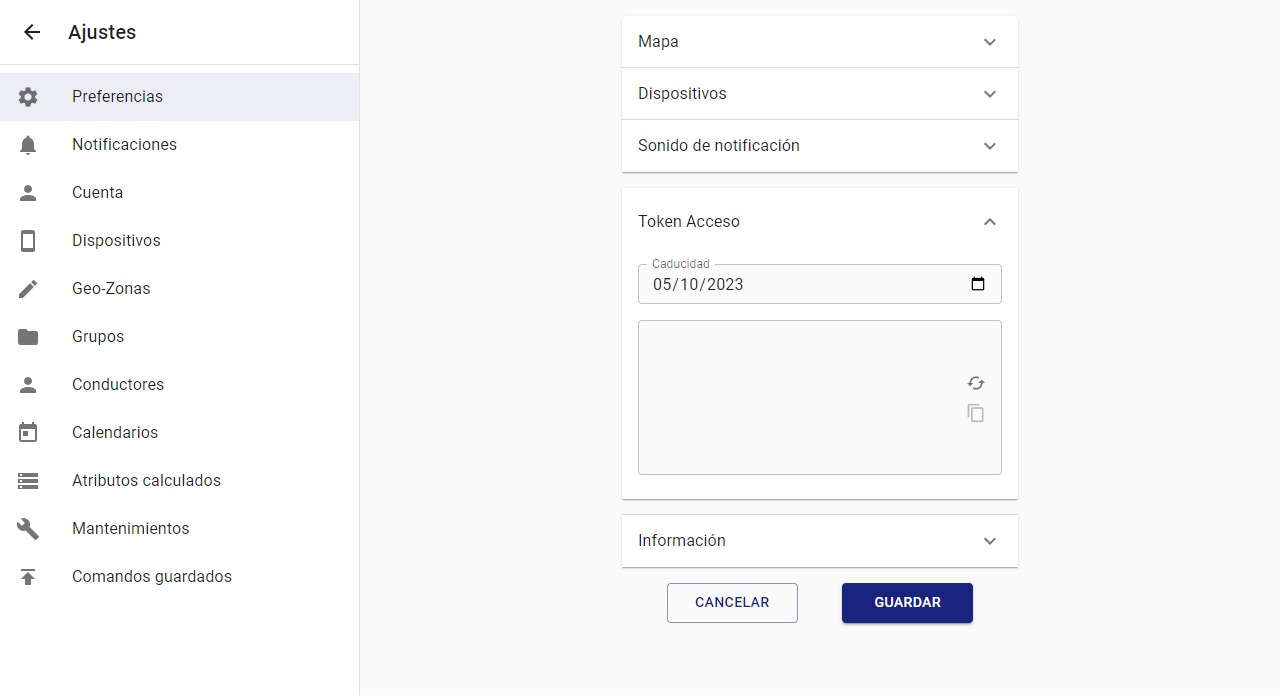How to use Traccar API
Traccar is a real-time vehicle geolocation company. I leave you some functional examples that will save you frustrations.
Although their API is relatively simple, it has been a bit tedious to get it working due to some details omitted from the documentation, how terse their forum responses are, and how confusing the error messages are (which seems like a 'collations' is really an authentication problem). So I have decided to publish what I learned in case it helps someone else.
In this article you will find two ways to obtain the positions using PHP and a common way to display them on a map with Javascript.
Getting the positions with PHP (API v5)
In this version you must first generate a token from the platform itself and then you can use it to identify yourself in subsequent calls.
I show you an image of where to get the token.

And here I leave you a simple code example.
<?
$path = __DIR__.'/';
$action = $_GET['action'] ?? null;
if($action=='positions') {
if($curl = curl_init('http://«Your Traccar Server»/api/positions')) {
$headers = [];
$headers[] = 'Authorization: Bearer «Your API Token»';
curl_setopt($curl, CURLOPT_COOKIEFILE, .'traccar.cookies');
curl_setopt($curl, CURLOPT_COOKIEJAR, .'traccar.cookies');
curl_setopt($curl, CURLOPT_USERAGENT, 'Mozilla/5.0 (Windows NT 6.2; WOW64; rv:17.0) Gecko/20100101 Firefox/17.0');
curl_setopt($curl, CURLOPT_CUSTOMREQUEST, 'GET');
curl_setopt($curl, CURLOPT_HTTPHEADER, $headers);
curl_setopt($curl, CURLOPT_FOLLOWLOCATION, true);
curl_setopt($curl, CURLOPT_RETURNTRANSFER, 1);
curl_setopt($curl, CURLINFO_HEADER_OUT, 1);
$resp = curl_exec($curl);
$info = curl_getinfo($curl);
curl_close($curl);
if($resp!==false && is_string($resp)) {
header('Content-Type: application/json');
die($resp);
} else {
header('Content-Type: text/plain');
var_dump($resp, $info);
die();
}
}
}
?>
<!DOCTYPE html>
<html>
<head>
<meta charset="utf-8" />
<meta name="viewport" content="initial-scale=1,width=device-width" />
<title>Traccar API Demo</title>
<style>
body {
margin : 20px;
background: #F5F5F5;
}
.gmaps {
aspect-ratio: 16 / 8;
}
</style>
</head>
<body>
<div id="gmaps" class="gmaps"></div>
<script src="traccar.js"></script>
</body>
</html>Creating a session and getting the positions with PHP (API v4)
The first step to use the API is to create a session. After this step you will get a Cookie and also a Token that only serves to confuse.
The second step is to obtain the positions of the different registered devices.
Algunos detalles a tener en cuenta.
- Although the parameter we send is called 'email', it is actually the username, for example 'admin'.
- In CURL configuration it is important to keep both 'CURLOPT_COOKIEFILE' and 'CURLOPT_COOKIEJAR'.
- I have left in the code how to recover the token although it has no further use.
<?
$path = __DIR__.'/';
$action = $_GET['action'] ?? null;
if(empty($action)) {
if($curl = curl_init('https://«Your Traccar Server»/api/session')) {
$headers = [];
$headers[] = 'Content-Type: application/x-www-form-urlencoded';
curl_setopt($curl, CURLOPT_COOKIEFILE, .'traccar.cookies');
curl_setopt($curl, CURLOPT_COOKIEJAR, .'traccar.cookies');
curl_setopt($curl, CURLOPT_USERAGENT, 'Mozilla/5.0 (Windows NT 6.2; WOW64; rv:17.0) Gecko/20100101 Firefox/17.0');
curl_setopt($curl, CURLOPT_CUSTOMREQUEST, 'POST');
curl_setopt($curl, CURLOPT_POST, true);
curl_setopt($curl, CURLOPT_POSTFIELDS, http_build_query(['email'=>'«Your user»','password'=>'«Your password»']));
curl_setopt($curl, CURLOPT_HTTPHEADER, $headers);
curl_setopt($curl, CURLOPT_FOLLOWLOCATION, true);
curl_setopt($curl, CURLOPT_RETURNTRANSFER, 1);
curl_setopt($curl, CURLINFO_HEADER_OUT, 1);
$resp = curl_exec($curl);
$info = curl_getinfo($curl);
curl_close($curl);
if($resp!==false && is_string($resp)) {
$resp = json_decode($resp);
if(is_object($resp)) {
$token = $resp->token;
} else {
die(json_last_error_msg());
}
} else {
header('Content-Type: text/plain');
var_dump($resp, $info);
die();
}
}
}
if($action=='positions') {
if($curl = curl_init('http://«Your Traccar Server»/api/positions')) {
$headers = [];
$headers[] = 'Authorization: Basic '.base64_encode('«Your user»:«Your password»');
curl_setopt($curl, CURLOPT_COOKIEFILE, .'traccar.cookies');
curl_setopt($curl, CURLOPT_COOKIEJAR, .'traccar.cookies');
curl_setopt($curl, CURLOPT_USERAGENT, 'Mozilla/5.0 (Windows NT 6.2; WOW64; rv:17.0) Gecko/20100101 Firefox/17.0');
curl_setopt($curl, CURLOPT_CUSTOMREQUEST, 'GET');
curl_setopt($curl, CURLOPT_HTTPHEADER, $headers);
curl_setopt($curl, CURLOPT_FOLLOWLOCATION, true);
curl_setopt($curl, CURLOPT_RETURNTRANSFER, 1);
curl_setopt($curl, CURLINFO_HEADER_OUT, 1);
$resp = curl_exec($curl);
$info = curl_getinfo($curl);
curl_close($curl);
if($resp!==false && is_string($resp)) {
header('Content-Type: application/json');
die($resp);
} else {
header('Content-Type: text/plain');
var_dump($resp, $info);
die();
}
}
}
?>
<!DOCTYPE html>
<html>
<head>
<meta charset="utf-8" />
<meta name="viewport" content="initial-scale=1,width=device-width" />
<title>Traccar API Demo</title>
<style>
body {
margin : 20px;
background: #F5F5F5;
}
.gmaps {
aspect-ratio: 16 / 8;
}
</style>
</head>
<body>
<div id="gmaps" class="gmaps"></div>
<script src="traccar.js"></script>
</body>
</html>Showing the vehicles on the map
This code for displaying vehicles meets the following guidelines:
- If a new vehicle appears, a new marker is created
- If a vehicle disappears, its marker is hidden
- Check the location of vehicles every 1 second.
- Keeps all vehicles visible by adjusting the map zoom until the user interacts with the zoom, then the user's decision is respected.
oTracer = {
markers: {},
autozoom: true,
init: function (gmap) {
this.gmap = gmap;
this.icon = new google.maps.MarkerImage('/flag0.svg', new google.maps.Size(32, 48), new google.maps.Point(0,0), new google.maps.Point(16, 48));
this.hint = window.setInterval(this.update.bind(this), 1000);
this.update();
google.maps.event.addListener(this.gmap, 'zoom_changed', (e) => {
this.autozoom = false;
});
},
update: function () {
fetch('traccar.php?action=positions').then(resp => {
resp.json().then(info => {
// console.log(info);
info = info.filter(location => location.latitude!==0 && location.longitude!==0);
const deviceIds = [];
const bounds = new google.maps.LatLngBounds();
info.map(location => {
deviceIds.push(location.deviceId);
let marker = this.markers[location.deviceId] ?? null;
const latlng = new google.maps.LatLng(location.latitude, location.longitude);
if(marker) {
marker.setPosition(latlng);
} else {
marker = new google.maps.Marker({ map: this.gmap, position: latlng, icon: this.icon, title: 'Vehículo '+location.deviceId });
this.markers[location.deviceId] = marker;
}
bounds.extend(latlng);
});
for(let deviceId in this.markers) {
deviceId = parseInt(deviceId);
this.markers[deviceId].setVisible(deviceIds.includes(deviceId));
}
if(this.autozoom) {
this.gmap.fitBounds(bounds); //auto-zoom
this.gmap.panToBounds(bounds); //auto-center
}
});
});
},
};
oGMaps = {
init: function () {
var elm = document.querySelector('.gmaps');
var script = document.createElement('script');
script.src = '//maps.google.com/maps/api/js?key=«Your Google Maps API Key goes here»';
script.onload = () => {
const latlng = new google.maps.LatLng(40.444, -3.69747);
const mapopts = { center: latlng, zoom: 6, mapTypeId: google.maps.MapTypeId.ROADMAP };
const gmaps = new google.maps.Map(document.querySelector('.gmaps'), mapopts);
oTracer.init(gmaps);
}
document.head.appendChild(script);
},
};
window.addEventListener('DOMContentLoaded', oGMaps.init.bind(oGMaps));© 2023 Mario Rocafull - Albin | Privacy policy ♥ Valencia, Spain